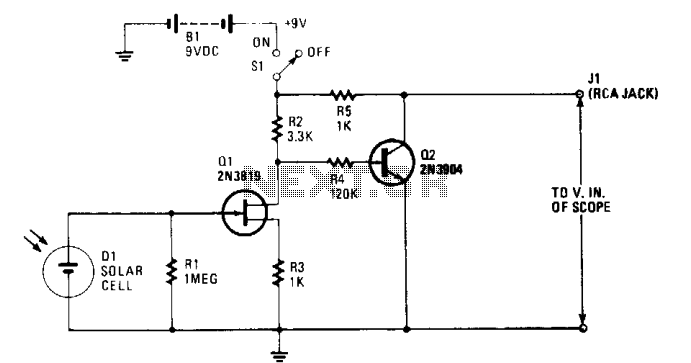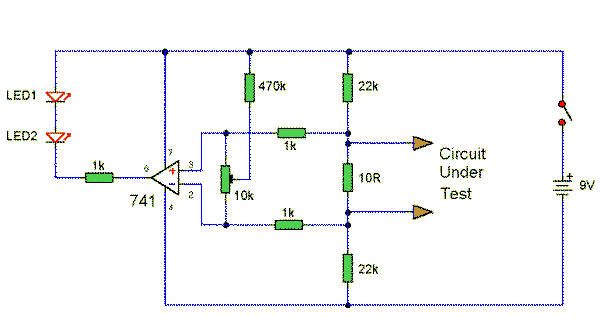
Diode tester

The circuit will display curves on an oscilloscope, depending on the state of the diode. To calibrate, replace the diode with a 1000-ohm resistor and adjust the oscilloscope gains for a 45-degree line. The drawings illustrate some expected results.
The described circuit is designed to visualize the behavior of a diode through an oscilloscope. The diode's state, whether forward-biased or reverse-biased, will influence the waveform displayed on the oscilloscope. In forward bias, the diode conducts, allowing current to flow and producing a characteristic voltage drop, while in reverse bias, it blocks current flow, resulting in a different voltage characteristic.
For calibration purposes, the diode can be temporarily replaced with a 1000-ohm resistor. This substitution allows for a controlled measurement of the voltage across the resistor, which can be used to set the oscilloscope gains accurately. The objective of adjusting the oscilloscope settings to display a 45-degree line indicates that the circuit is likely intended to demonstrate a linear relationship between voltage and current under certain conditions.
The expected results, as indicated in the drawings, may include various waveforms corresponding to different states of the diode. These could range from simple linear responses to more complex nonlinear behaviors, highlighting the diode's characteristics such as forward voltage drop and reverse recovery time. The oscilloscope serves as a critical tool in visualizing these electrical phenomena, providing insight into the diode's operational limits and performance in various circuit configurations.The circuit will display curves on a scope, contingent on the state of the diode. To ' 'calibrate,'' substitute a 1000-ohm resistor for the diode and adjust the scope gains for a 45-degree line. The drawings show some expected results.
The described circuit is designed to visualize the behavior of a diode through an oscilloscope. The diode's state, whether forward-biased or reverse-biased, will influence the waveform displayed on the oscilloscope. In forward bias, the diode conducts, allowing current to flow and producing a characteristic voltage drop, while in reverse bias, it blocks current flow, resulting in a different voltage characteristic.
For calibration purposes, the diode can be temporarily replaced with a 1000-ohm resistor. This substitution allows for a controlled measurement of the voltage across the resistor, which can be used to set the oscilloscope gains accurately. The objective of adjusting the oscilloscope settings to display a 45-degree line indicates that the circuit is likely intended to demonstrate a linear relationship between voltage and current under certain conditions.
The expected results, as indicated in the drawings, may include various waveforms corresponding to different states of the diode. These could range from simple linear responses to more complex nonlinear behaviors, highlighting the diode's characteristics such as forward voltage drop and reverse recovery time. The oscilloscope serves as a critical tool in visualizing these electrical phenomena, providing insight into the diode's operational limits and performance in various circuit configurations.The circuit will display curves on a scope, contingent on the state of the diode. To ' 'calibrate,'' substitute a 1000-ohm resistor for the diode and adjust the scope gains for a 45-degree line. The drawings show some expected results.





